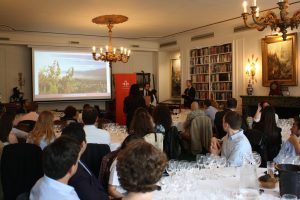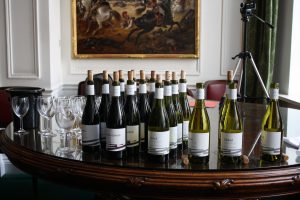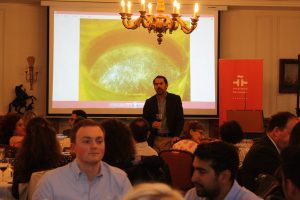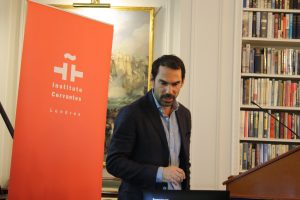Learn how to prepare an Asturian fabada bean stew with Hispania
Hispania’s premises, with more than 9,000 square feet are part of the ground floor of the historical building of Lloyds Bank. Hispania is located at 72-74 Lombard Street, one of the most emblematic streets of London, across Bank Underground Station, in the heart of the City.
With two floors dedicated to show the best of Spain, Hispania is the largest, most accomplished and ambitious project devoted to Spanish gastronomy in Europe And with almost 50 meters of facade and 8.5 meters total height, Hispania holds a license to operate as a restaurant, bar, shop and take-away.
Almost 9,000 square feet of space make Hispania a proper flagship store of Spanish cuisine, food and culture.
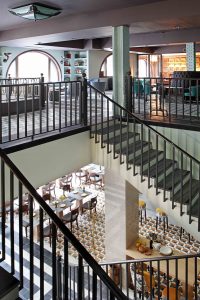
Hispania in London
Designed by the renowned interior designer and antique dealer Lorenzo Castillo and under the gastronomic coordination of award-winning chef Marcos Moran, Hispania is the latest great culinary sensation, offering the best experience of Spanish lifestyle, gastronomy, and culture in London. The prominent architect Tommy Tait, who also designed the well-known Selfridges department store, planned the building where Hispania’s premises are located. In 2007, the building went through a full refurbishment valued at more than 65 million pounds, being converted into premium office space.
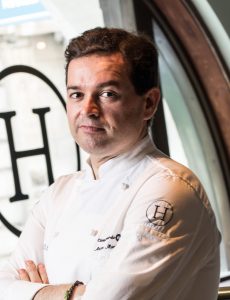
Award-winning chef Marcos Moran
Fabada de Prendes, for 4 people
Ingredients:
500 kg of dried beans or 1 kg of fresh beans (in this case there is no soaking)
2 Asturian black pudding
2 Asturian chorizos
1/4 of a saffron sachet
A small piece of unsalted bacon
60cl of oil
1 teaspoon chopped onion
Salt to taste
¼ teaspoon sweet paprika
200cl of chicken broth
1 small piece of pork
METHOD:
- Soak the beans in cold water the night before you plan to make your fabada.
- First, cook the chorizos, bacon and black pudding in water (just enough to cover them in the pan) for 10 minutes to degrease them.
- Now, in a separate pan, bring the beans to a slow boil and scoop out the foam that starts to form on top of the water. Boil for approximately 20 minutes.
- Add the oil, chopped onion and sweet paprika to the pan with the beans.
- Next, add a little water to the saffron to make a little broth and then tip this into the fabada also.
- Season the beans with salt and pepper then, turn off the heat and let the beans rest.
- Turn the heat back to low and cook slowly for an hour and a half, making sure to top up the broth they’re cooked in so that they don’t boil dry.
- The fabada will be ready when the beans are still holding their shape but soft enough that they taste creamy and delicate.
PRESENTATION
Traditionally, we present the beans and the meat separately.
The broth must be somewhat thick; if it is very liquid, it is advisable to pass some beans through a sieve and incorporate them into the pot to thicken the broth.
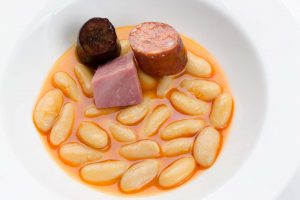
Asturian fabada bean stew
Aprende a hacer la auténtica fabada asturiana de la mano de Hispania
Las instalaciones del restaurante Hispania en Londres son parte de la planta baja del edificio histórico de Lloyds Bank. Hispania está ubicado en 72-74 Lombard Street, una de las calles más emblemáticas de Londres, al otro lado de la estación de metro Bank, en el corazón de la ciudad.
Con dos pisos dedicados a mostrar lo mejor de España, Hispania es el proyecto más grande, exitoso y ambicioso dedicado a la gastronomía española en Europa. Y con casi 50 metros de fachada y 8,5 metros de altura total, Hispania tiene licencia para operar como restaurante, bar, tienda y comida para llevar. Casi 9,000 pies cuadrados de espacio hacen de Hispania una tienda insignia de la cocina, comida y cultura española.

Las instalaciones del restaurante Hispania en Londres
Diseñado por el reconocido diseñador de interiores y anticuario Lorenzo Castillo y bajo la coordinación gastronómica del galardonado chef Marcos Morán, Hispania es la última gran sensación culinaria, que ofrece la mejor experiencia del estilo de vida, la gastronomía y la cultura española en Londres. El destacado arquitecto Tommy Tait, quien también diseñó los famosos grandes almacenes Selfridges, planeó el edificio donde se encuentran las instalaciones de Hispania. En 2007, el edificio se sometió a una renovación completa valorada en más de 65 millones de libras.

El chef Marcos Morán
Fabada de Prendes, para 4 personas
Ingredientes:
500 kg de fabes seca o 1 kg de fabes frescas (en este caso no hay remojo)
1,5 o 2 morcillas asturianas
2 chorizos asturianos
1/4 sobres de azafrán
Un pequeño trozo de panceta desalada
60 cl de aceite
40 cl de aceite
Una cucharadira de cebolla picada
Sal al gusto
¼ de cucharadita de pimentón dulce
200 cl de caldo de gallina
1 trozo pequeño lacón
MODO DE HACER:
Poner a remojo en agua fría las fabes la noche anterior.
La proporción de agua es de tres a uno, es decir, 500gm por 1 litros. Al día siguiente se ponen las fabes, la panceta y los 60 cl de aceite en recipiente apropiado).
Cocer 10 minutos los chorizos y las morcillas en agua aparte para desgrasar y agregar a la fabada. Antes de empezar el hervor debemos espumar las fabes de las impurezas de la propia legumbre. Aparte, a los 20 minutos del hervor se prepara un sofrito con los 125 cl de aceite, la cebolla picada y el pimentón dulce y lo incorporamos a la fabada con el azafrán diluido en un poco de caldo. Salamos en este momento. Tras el sofrito apagar el fuego y dejar que las fabes reposen. Una vez las fabes reposadas dejamos cocer lentamente durante hora y media teniendo la precaución de ir agregando el caldo que necesiten, nunca pueden dejar de estar cubiertas.
La fabada estará lista cuando las fabes tengan una textura íntegra pero la vez cremosa y delicada en boca.
En recipiente aparte cocemos en agua el lacón para acompañar a las fabes.
FINAL Y PRESENTACIÓN
Presentamos las fabes en legumbrera y el compango troceado en fuente aparte.
El caldo ha de quedar algo espeso; si está muy líquido es aconsejable pasar unas fabes por el pasapurés e incorporarlas al potaje

Un plato de fabada asturiana
The new Spanish wine, to conquer London
London hosted a wine tasting of Valdesil wineries organised by Institute Cervantes in London, by Juan Manuel Bellver, one of Spain’s best-known food and wine critics.
Bellver presented Spanish wine history through a map in which he commented the protected designation of origin throughout Spanish geography, regions of vineyards that are protected. «London in one of the European cities where wine of all kinds it is most appreciated and particularly the fortified, among which our Jerez has almost no rival», explained the general director of Lavinia Spain.
«To come here to talk about Spanish wine to such an interested audience, within the framework of a historic club like The Rag, has been an enriching and fascinating experience. The tasting allowed the attendees to enjoy in their glass the fascinating history of unknown wineries, centuries-old vines, steep slopes and dreamer vineyards that I had previously told them,” Bellver said.
Institute Cervantes in London organised the tasting in collaboration with the Spanish Wine Federation. It took place in the prestigious private club of The Rag-the Army and Navy, founded in 1837, located in St James: the heart of the capital. Originally for military and naval officers, it now welcomes everyone.
Six wines were tasted; four whites and two reds. All are currently for sale in the United Kingdom – Valdesil Sobre Lías 2018 (white wine, godello grape), Valdesil Sobre Lías 2013 (white wine, godello grape), Pezas da Portela 2016 (white wine, godello grape), O Chao 2016 (white wine, godello grape), Valderroa 2016 (red wine, mencía grape) and Valderroa Carballo 2015 (red wine, mencía grape).
This was the first of a series of lectures and wine tastings organised by the Cervantes Institute in London, which featured the first encounter with wines from the northwest of Spain, specifically from Valdeorras, in Galicia.
Borja Prada is the technical director of Valdesil and seventh generation of a family dedicated to wine. He explained how the British market was the first export for Bodegas Valdesil, starting the commercialisation of wines in 1993.
«For Valdesil the British market has been a great challenge, because it is the most demanding market in the world, but also a great satisfaction, because it confirms that the wines made by Valdesil are world class, and that they compete with the best,» says Prada.
In addition, the winemaker adds how the British market has also been «a source of joy”. This is due to the quality of the wines, which have been praised by British critics, and reviewed in publications such as: The Guardian, The Daily Telegraph, and also on the BBC, «Saturday Kitchen Live» programme.
El nuevo vino español, a la conquista de Londres
Londres acogió una cata de vinos de las bodegas Valdesil organizada por el Instituto Cervantes de Londres, a cargo de Juan Manuel Bellver, uno de los críticos gastronómicos y de vinos más conocidos de España.
Bellver presentó la historia vinícola española a través de un mapa en la quecomentó las denominaciones de origen de la geografía española. “Londres en una de las ciudades europeas donde más se aprecia el vino de todas las clases y particularmente los fortificados, entre los cuales nuestro Jerez casi no tiene rival”, explicó el director general de Lavinia España.
“Venir aquí a hablar de vino español ante un auditorio tan interesado, en el marco de un club histórico como The Rag, ha sido una experiencia enriquecedora y fascinante. La cata permitió a los asistentes disfrutar en su copa de esa historia fascinante de comarcas vinícolas ignotas, cepas centenarias, laderas escarpadas y viñadores soñadores que yo les había contado previamente”, destacó Bellver.
La cata organizada por el Instituto Cervantes de Londres en colaboración con la Federación Española del Vino, tuvo lugar en el prestigioso club privado de The Rag- the Army and Navy, fundado en 1837, originalmente para oficiales militares y navales, pero que ahora da la bienvenida a hombres y mujeres profesionales, tanto de origen militar como civil, y situado en St James, en el corazón de la capital británica.
Se cataron seis vinos, cuatro blancos y dos tintos, que están actualmente a la venta en el Reino Unido:Valdesil Sobre Lías 2018 (vino blanco, uva godello), Valdesil Sobre Lías 2013 (vino blanco, uva godello), Pezas da Portela 2016 (vino blanco, uva godello),O Chao 2016 (vino blanco, uva godello), Valderroa 2016 (vino tinto, uva mencía) y Valderroa Carballo 2015 (vino tinto, uva mencía).
Esta fue la primera de una serie de charlas y catas de vinos que organizará el Instituto Cervantes de Londres, que contó en el primer encuentro con vinos del noroeste de España, en concreto de Valdeorras, en Galicia.
Borja Prada, director técnico de Valdesil y miembro de la séptima generación familiar dedicada al vino explicó cómo el mercado británico fue el primero de exportación para Bodegas Valdesil, iniciando la comercialización de los vinos en 1993.
“Para Valdesil el mercado británico ha supuesto un gran reto, pues es el mercado más exigente del mundo, pero también una gran satisfacción, pues confirma que los vinos que elabora Valdesil son de clase mundial, y que compiten con los mejores”, comenta Prada.
Además, el enólogo reconoce como el mercado británico ha sido también “una fuente de alegría”, ya que la calidad de los vinos ha sido elogiada por los críticos británicos, y los vinos han sido reseñados en medios de comunicación como «The Guardian», «The Daily Telegraph», «Financial Times», «The Daily Mirror», y también en la BBC, en el programa «Saturday Kitchen Live”.
Language Exchage Event II
Fancy participating in our new conversation club?
 Some of the Instituto Cervantes London teachers have set a language exchange group so that they and other Spanish expats can improve their English while helping students to use their Spanish outside the classroom.
Some of the Instituto Cervantes London teachers have set a language exchange group so that they and other Spanish expats can improve their English while helping students to use their Spanish outside the classroom.
The next meeting is being held upstairs at The Antelope, 22 Eaton Terrace, London SW1W 8EZ – a two-minute walk from the Instituto Cervantes towards Sloane Square – on Thursday January 20, from 7pm onwards.
The idea is that the meeting is informal, friendly and fun – and there’ll be no membership fees or anything like that, just a chat over a drink or two. All welcome!
The Antelope is a traditional, welcoming British boozer, with a reputation for serving a selection of well-kept ales.
¿Te apetece participar en el próximo Club de la Conversación?
 Algunos profesores del Instituto Cervantes de Londres estamos organizando el segundo grupo de intercambio de idiomas entre españoles e ingleses para ayudar a los alumnos a practicar el español fuera de sus clases.
Algunos profesores del Instituto Cervantes de Londres estamos organizando el segundo grupo de intercambio de idiomas entre españoles e ingleses para ayudar a los alumnos a practicar el español fuera de sus clases.
El segundo encuentro tendrá lugar en el pub The Antelope, 22 Eaton Terrace, London SW1W 8EZ – a dos minutos andando desde el Instituto Cervantes hacia Sloane Square- el jueves 20 de enero, a partir de las 19.00.
La idea es tener un encuentro informal, agradable y divertido, sin inscripciones ni cuotas, simplemente pasar el rato y tomar unas copas.
The Antelope es una tradicional tasca británica, con una reputación de servir una amplia selección de cervezas.¡Nos vemos allí!
Language Exchange Event
 Fancy improving your Spanish in the comfort of a proper English pub?
Fancy improving your Spanish in the comfort of a proper English pub?
Some of the Instituto Cervantes London teachers are setting up a language exchange group so that they and other Spanish expats can improve their English while helping students to use their Spanish outside the classroom.
The first meeting is being held upstairs at The Antelope, 22 Eaton Terrace, London SW1W 8EZ – a two-minute walk from the Instituto Cervantes towards Sloane Square – on Thursday November 18, from 7pm onwards.
The idea is that the meeting is informal, friendly and fun – and there’ll be no membership fees or anything like that, just a chat over a drink or two. If the first one is a success, the teachers hope to make it a regular monthly event in the New Year. The Antelope is a traditional, welcoming British boozer, with a reputation for serving a selection of well-kept ales.
___________________________________________________________________________
¿Te apetece practicar tu inglés en un tradicional pub británico?
Los profesores del Instituto Cervantes de Londres quieren crear un grupo de intercambio de idiomas entre españoles e ingleses para ayudar a sus alumnos a practicar el español fuera de sus clases.
El primer encuentro tendrá lugar en el pub The Antelope, 22 Eaton Terrace, London SW1W 8EZ – a dos minutos andando desde el Instituto Cervantes hacia Sloane Square- el jueves 18 de Noviembre, a partir de las 19.00.
19.00.
La idea es tener un encuentro informal, agradable y divertido, sin inscripciones ni cuotas, simplemente pasar el rato y tomar unas copas. Si este primer encuentro tiene éxito, los profesores esperan hacerlo mensualmente.The Antelope es una tradicional tasca británica, con una reputación de servir una amplia selección de cervezas.¡Nos vemos allí!
How to make the perfect paella
 SPANISH cuisine has been very much a la moda for a while now, thanks in no small part to the iconic Ferran Adrià and El Bulli, plus a growing realisation among other cultures that tapas are a great way to eat.
SPANISH cuisine has been very much a la moda for a while now, thanks in no small part to the iconic Ferran Adrià and El Bulli, plus a growing realisation among other cultures that tapas are a great way to eat.
Attempting Adrià’s experimental recipes at home is beyond most of us, but a good paella is another matter – especially if you’ve had a lesson from the professionals.
London restaurant group PINCHITOtapas is running a masterclass at 10am this Sunday, July 25, at its branch in Bayley Street, WC1 (near Goodge Street and Tottenham Court Road tube stations).
Up for the copa…
ANTICIPATION has been quietly but steadily building among London’s Spanish community in the past few days, and it’s now ready to explode on Wednesday night.
So where best to watch the action and enjoy the atmosphere as Spain take on Germany in the World Cup semi-final?
Most of the 200 or so Spanish bars and restaurants in the capital should be a good bet, but unfortunately the British half of LondonSpanish will only to get to glance up at the big screen in the office while at my other job. Otherwise my choice would probably be Camino, just across the road from King’s Cross station. It’s a spacious venue with good bar service and an excellent outdoor space.
A quick look at these YouTube scenes after Spain’s triumph at the 2008 European Championships would seem to indicate that Soho and the rest of the West End will be quite lively. If you’ve got some Spanish friends you’ll soon create your own atmosphere in your chosen bar or pub. If not, just follow the red and yellow flags and shirts to find a good spot.
Continue Reading… LondonSpanish
